《2017厦门大学814阅读及英美文学、语言学基础考研专业课复习全书》(含真题与答案解析)
2011年厦门大学考研真题 阅读及英美文学、语言学基础
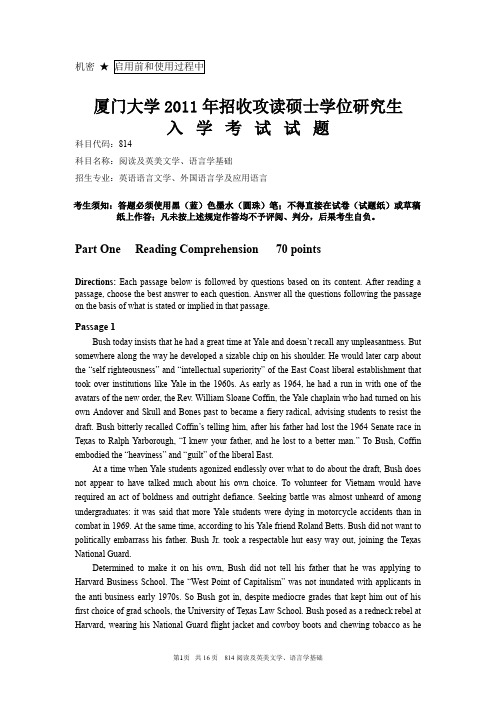
机密★厦门大学2011年招收攻读硕士学位研究生入学考试试题科目代码:814科目名称:阅读及英美文学、语言学基础招生专业:英语语言文学、外国语言学及应用语言考生须知:答题必须使用黑(蓝)色墨水(圆珠)笔;不得直接在试卷(试题纸)或草稿纸上作答;凡未按上述规定作答均不予评阅、判分,后果考生自负。
Part One Reading Comprehension 70 pointsDirections:Each passage below is followed by questions based on its content. After reading a passage, choose the best answer to each question. Answer all the questions following the passage on the basis of what is stated or implied in that passage.Passage 1Bush today insists that he had a great time at Yale and doesn‟t recall any unpleasantness. But somewhere along the way he developed a sizable chip on his shoulder. He would later carp about the “self-righteousness” and “intellectual superiority” of the East Coast liberal establishment that took over institutions like Yale in the 1960s. As early as 1964, he had a run-in with one of the avatars of the new order, the Rev. William Sloane Coffin, the Yale chaplain who had turned on his own Andover-and-Skull-and-Bones past to became a fiery radical, advising students to resist the draft. Bush bitterly recalled Coffin‟s telling him, after his father had lost the 1964 Senate race in Texas to Ralph Yarborough, “I knew your father, and he lost to a better man.” To Bush, Coffin embodied the “heaviness” and “guilt” of the liberal East.At a time when Yale students agonized endlessly over what to do about the draft, Bush does not appear to have talked much about his own choice. To volunteer for Vietnam would have required an act of boldness and outright defiance. Seeking battle was almost unheard of among undergraduates: it was said that more Yale students were dying in motorcycle accidents than in combat in 1969. At the same time, according to his Yale friend Roland Betts. Bush did not want to politically embarrass his father. Bush Jr. took a respectable hut easy way out, joining the Texas National Guard.Determined to make it on his own, Bush did not tell his father that he was applying to Harvard Business School. The “West Point of Capitalism” was not inundated with applicants in the anti-business early 1970s. So Bush got in, despite mediocre grades that kept him out of his first choice of grad schools, the University of Texas Law School. Bush posed as a redneck rebel at Harvard, wearing his National Guard flight jacket and cowboy boots and chewing tobacco as hesat back of the class, spitting into a paper cup. But he showed early signs of the self-discipline that would become more characteristic as time went on. He kept up with the gruelling casework, particularly in a course called Human Organization and Behaviour. Here were formal lessons in organizing and managing people that Bush had only intuited as an Andover cheerleader. He developed his basic approach to leadership at Harvard‟s training ground for future CEOs. The essence was to think Big Picture, don‟t get caught in the details, delegate and decide. Bush whizzes through briefing books today, preferring to listen rather than read, but his friends say he was an ability to cut to the chase. If Bush seems less substantive than a Bill Clinton—or an Al Gore—he can blame a Harvard education.1. Which of the following does the author probably agree?(A) Bush was an activist in anti-Vietnam war when he studied at Yale.(B) Bush liked the self-righteousness atmosphere at Yale.(C) Bush seemed to be politically-different from most college students at that time.(D) Bush was proud of his education at Yale.2. Bush chose to join the Texas National Guard mainly(A) because of his father(B) for the sake of Coffin‟s advice(C) because of his anti-Vietnam War attitude(D) because of the pressure from his Yale classmates3. He entered Harvard Business School instead of the University of Texas Law School because(A) Harvard was his first choice(B) his grades were not high enough(C) he intended to venture into business(D) he liked the intellectual superiority of the liberal establishment at Harvard4. He kept his application to Harvard Business School from his father mainly(A) because he did not trust his father(B) because his father would have thwarted it(C) because an anti-business atmosphere was prevalent in America then(D) because he wanted to be independent and self-reliant5. According to the author, Bush‟s leading style was developed(A) as a heritage from the family(B) during his education at Yale(C) as a result of the political atmosphere when he was young(D) during his learning at HarvardPassage 2The Enlightenment favoured a view of universe structured in binary oppositions, the principle of which is the dichotomy between subject and object. This was an essential division that world enable a systematic and disengaged view of reality and would foster the development of science even though it was also highly stimulated by the latter. Other dualisms, such as that of the individual/society, and the “We/They”dichotomy, based on race or ethnicity, for example, stemmed from the general idea of a necessary division and a controlling/controlled type of relationship between subject and object where “the distance between subject and object, a presupposition of abstraction, is grounded in the distance from the thing itself which the master achieved through the mastered”(Horkmeimer & Adorno, 1972:13). Distance, abstraction and control are key elements in the contact between subject and object.This objectifying attitude of the subject towards the object, which was previously described as instrumental reason, justified human control over nature, which is now very much contested by radical ecologists who view animals, plants and even minerals as subjects (Ferry, 1992). Likewise, it has determined a descriptive type of knowledge about the object of research, either human or non-human. Consequently, a scientific analysis should imply a distant, disengaged, monological, objective and objectifying view of the object by subject.Critical Theory, on the contrary, emphasizes the “rootedness of our cognitive accomplishments” (Habermas, 1994:87). Critical theorists reject both the atomistic concept of the individual and unilateral concentration of power implied in a subject-object interaction and concentrate on the creative and democratic potential of a subject-subject relationship.Although the concept of object disappears from the equation, this is not the only alteration because there is also an essential change in the notion of subject. The concept of a solitary subject which ruled the enlightened way of thinking is definitely overcome by the notion of a social subject, and this is not an idea exclusive to the Frankfurt School but an assumption that underpins contemporary philosophical thought. Habermas identifies four “themes”common to the philosophical movements of this century “in spite of the boundaries between schools” which he designates as “postmetaphysical thinking, the linguistic turn, situating reason, and overcoming logocentrism” (Habermas, 1992:8). The change in the subject is inherent in all these themes which refer to a reconsideration of scientific rationality, to the move from the philosophy of consciousness to the philosophy of language, to the embeddedness of reason in culture and history and finally to the relocation of theory within practice. As Habermas points out, this is an evolution that has been developing throughout the twentieth century. However, Habermas expanded this idea in a particular way which is eventually, more restrictive precisely because it is normative and consensus driven.Bearing in mind the four themes mentioned above, the notion of the “intersubjectively recognized subject”, in Habermas‟ terms challenge, with regard to scientific and social research, the premises of pure, instrumental reason and, consequently, the distance maintained between theory and practice and advocated dialogical and, occasionally, even overlapping positions in subject-subject research. Likewise, as far as language is concerned, the change from the paradigm of subjectivity into the paradigm of intersubjectivity, or from the “paradigm of consciousness” intothe “paradigm of language” as Habermas puts it, implies using language within the framework of “communicative action”. This requires the capacity to establish “interpersonal relations” instead of simply practicing an exercise of subject-centred”reasoning for representational or strategic purposes, that is, aiming at descriptive knowledge or at success-oriented expression or intervention (Habermas. 1984:86; 1987b:314).The intersubjectivistic orientation of the subject still differs from the subjectivistic one in that the subject draws her/his self-identification and self-representation from the ways that others identify and represent her/him while in interaction, that is through “intersubjectively recognized self-identification”and “on the basis of the Intersubjective recognition of reciprocal self-representations”(Habermas, 1979:107). The fact that the process of Intersubjective self-identification and self-representation takes place while in interaction is emphasized by Habermas and justifies the dynamic and impermanent nature of the intersubjective subject. Moreover, he notes, there is a “complementary relation between ego and group identity”due precisely to the above-mentioned process that also generates the interconnectedness between the formation of self and group identities since they develop through reciprocal exchange (Habermas, 1979:111)Communication is thus an essential element in the formation of self and group identities because it mediates processes that constitute what Habermas calls the …personal life‟which comprehends …all possible experiences and actions that can be attributed to the individual in his exchange with his social environment‟and that enable the acquisition of knowledge and the transmission of culture within the social system (Habermas, 1979:111). At the same time, language may set limits for a social system which itself represents the “symbolic boundary” and “the horizon of the actions that member reciprocally attribute to themselves internally” (Habermas, 1979:111). Therefore, the linguistically mediated experiences which are both the lifeworld of an individual and the social system with which s/he integrates. More specifically, the scope of possible communicative interactions that are …intersubjectively recognized‟lies within the normative framework of that social system.6. The word “epistemic” mostly approximately means:(A) plagued(B) subject-objective(C) popularized(D) cognitive7. The phrase “the embeddedness of reason in culture and history” can be interpreted as:(A) Culture and history give rise to reason.(B) Culture and history determine what kind of reasoning power you have.(C) The faculty of reasoning can be explained with reference to specific culture and history.8. Which of the following titles is likely to be the title of the book written by Habermas in 1979?(A) Communication and the evolution of society(B) Postmetaphysical thinking(C) The theory of communicative action(D) Toward a rational society9. Which of the following titles do you think best suits this excerpt?(A) Changes in subject-object relations(B) Intersubjective reason(C) The information of self and group identities(D) Habermas and the Frankfurt School10. How many articles and books did the author refer to when he wrote this passage?(A) nine(B) ten(C) eleven(D) sevenPassage 3As I indicated earlier, the analysis of JUDGEMENT is complicated by the need to distinguish between what can be termed …inscribed‟ (or explicit) JUDGEMENT and what we term …token‟ of Judgement (implicit). Under the inscribed/explicit category, the evaluation is explicitly presented by means of a lexical item carrying the JUDGEMENT value, such as, skilfully, corruptly, lazily etc. It is possible, as I have indicated, for JUDGEMENT values to be evoked rather than inscribed by what we call …token‟ of JUDGEMENT. Under these tokens, JUDGEMENT values are triggered by what can be viewed as simply …facts‟, apparently unevaluated descriptions of some event or state of affairs. The point is that these apparently …factual‟ or informational meanings nevertheless have the capacity in the culture to evoke JUDGEMENTAL responses (depending upon the reader‟s social/culture/ideological reading position). Thus a commentary may inscribe a JUDGEMENT value of negative capacity by accusing the government of …incompetence‟ or, alternatively, evoke the same value by means of a token such as …the government did not lay the foundations for long term growth‟. There is, of course, nothing explicitly evaluative about such an observation but it nonetheless has the potential to evoke evaluations of incompetence in readers who share a particular view of economics and the role of government. Similarly, a reporter might explicitly evaluate the behaviour of, for example, a Californian suicide cult as …bizarre‟ or …aberrant‟ or they might evoke such appraisals by means of tokens such as …They referred to themselves as “angles”or …They filled the mansion with computers and cheap plastic furniture‟. Such tokens, of course, assume shared social norms. They rely upon conventionalized connections between actions and evaluations. As such, they are highly subject to reader position—each reader will interpret a text‟stokens of judgement according to their own cultural and ideological positioning. They are also subject to influence by the co-text, and an important strategy in the establishment of interpersonal positioning in a text is to stage inscribed and evoked evaluation in such a way that the reader shares the writer‟s interpretations of the text‟s tokens.In some instances, the ethical evaluation invoked by some …factual‟ description (a token) will have become so naturalized or taken-for-granted in a given cultural situation that it is likely to be regarded as explicit (inscribed) rather than as implicit (evoked).JUDGEMENT. Consider, for example,They ordered a pizza and then shot the deliveryman in the head at a point-blank range.Now the moral evaluation associated with such as action is so firmly established in our culture as to be virtually automatic. Nevertheless, it is still useful to distinguish between token (implicit JUDGEMENT) and inscription (explicit JUDGEMENT) in these contexts. The writer always has the choice between the token, the description couched essentially in experiential or …factual‟ terms (…They shot the man in the head at point-blank range‟) and a description couched in the explicitly evaluative terms of explicit/inscribed Judgement (…They murdered him, heinously, callously and in cold-blood.‟) Since the choice is always available it remains meaningful and significant and should not be overlooked in the analysis, however …automatic‟ the connection between the factual description and the JUDGEMENT value it implies.11. In which of the following fields of study do you think this author is a researched?(A) Text analysis of legal cases(B) Interpersonal semantics(C) Evaluation of texts(D) Media discourse analysis12. What type of text does this passage belong to?(A) A legal interpretation(B) A textbook(C) A research article(D) A workshop presentation13. Which of the following titles do you think best suits this passage?(A) Implicit versus explicit attitudinal positioning(B) Functions of adjectives(C) Evaluation of judgemental expressions(D) Inscriptions and descriptions14. The phrase “JUDGEMENT value” would best be replaced by:(A) Praise(B) Feeling(C) Attitude(D) Ideological reading position15. Which of the following words or phrases best replace the word “token” in this passage?(A) symbolic expression(B) interpersonal position(C) implication(D) simple statementPassage 4In the two decades between 1910 and 1930, over ten percent of the Black population of the United States left the South, where the preponderance of the Black population had been located, and migrated to northern states, with the largest number moving, it is claimed, between 1916 and 1918. It has been frequently assumed, but not proved, that the majority of the migrants in what has come to be called the Great Migration came from rural areas and were motivated by two concurrent factors: the collapse of the cotton industry following the boll weevil infestation, which began in 1898, and increased demand in the North for labor following the cessation of European immigration caused by the outbreak of the First World War in 1914. This assumption has led to the conclusion that the migrants‟ subsequent lack of economic mobility in the N orth is tied to rural background, a background that implies unfamiliarity with urban living and a lack of industrial skills.But the question of who actually left the South has never been rigorously investigated. Although numerous investigations document an exodus from rural southern areas to southern cities prior to the Great Migration, no one has considered whether the same migrants then moved on to northern cities. In 1910 over 600,000 Black workers, or ten percent of the Black work force, reported thems elves to be engaged in “manufacturing and mechanical pursuits,” the federal census category roughly encompassing the entire industrial sector. The Great Migration could easily have been made up entirely of this group and their families. It is perhaps surprising to argue that an employed population could be enticed to move, but an explanation lies in the labor conditions then prevalent in the South. About thirty-five percent of the urban Black population in the South was engaged in skilled trades. Some were from the old artisan class of slavery—blacksmiths, masons, carpenters—which had had a monopoly of certain trades, but they were gradually being pushed out by competition, mechanization, and obsolescence.The remaining sixty-five percent, more recently urbanized, worked in newly developed industries—tobacco, lumber, coal and iron manufacture, and railroads. Wages in the South, however, were low, and Black workers were aware, through labor recruiters and the Black press, that they could earn more even as unskilled workers in the North than they could as artisans in the South. After the boll weevil infestation, urban Black workers faced competition from the continuing influx of both Black and White rural workers, who were driven to undercut the wages formerly paid for industrial jobs. Thus, a move north would be seen as advantageous to a group that was already urbanized and steadily employed, and the easy conclusion tying their subsequent economic problems in the North to their rural background comes into question.16. The author indicates explicitly that which of the following records has been a source ofinformation in her investigation?(A) United States Immigration Service reports from 1914 to 1930(B) Payrolls of southern manufacturing firms between 1910 and 1930(C) The federal census of 1910(D) Advertisements of labor recruiters appearing in southern newspapers after 191017. The author cites each of the following as possible influences in a Black worker‟s decision tomigrate north in the Great Migration EXCEPT(A) wage levels in northern cities(B) labor recruiters(C) competition from rural workers(D) voting rights in northern states18. It can be inferred from the passage that the “easy conclusion” mentioned in line 53 is based onwhich of the following assumptions?(A) People who migrate from rural areas to large cities usually do so for economic reasons.(B) Most people who leave rural areas to take jobs in cities return to rural areas as soon as itis financially possible for them to do so.(C) People with rural backgrounds are less likely to succeed economically in cities than arethose with urban backgrounds.(D) Most people who were once skilled workers are not willing to work as unskilled workers.19. The primary purpose of the passage is to(A) support an alternative to an accepted methodology(B) present evidence that resolves a contradiction(C) introduce a recently discovered source of information(D) challenge a widely accepted explanation20. According to information in the passage, which of the following is a correct sequence ofgroups of workers, from highest paid to lowest paid, in the period between 1910 and 1930?(A) Artisans in the North; artisans in the South; unskilled workers in the North; unskilledworkers in the South(B) Artisans in the North and South; unskilled workers in the North; unskilled workers in theSouth(C) Artisans in the North; unskilled workers in the North; artisans in the South(D) Artisans in the North and South; unskilled urban workers in the North; unskilled ruralworkers in the SouthPassage 5(本文节选于Critical Citizens for an Intercultural World: Foreign Language Education as Cultural Politics一书Chapter TwoPhilosophical Foundations for Critical Cultural Awareness。
厦门大学英美文学考研真题及参考答案(2008~2011)【圣才出品】

厦门大学英美文学考研真题及参考答案(2008~2011)厦门大学2011年英美文学考研真题考试科目:阅读及英美文学、语言学基础1. Write down the names of the authors of the following works (8 points):A. The Life and Opinion of Tristram-Shandy【答案】Laurence Sterne【解析】《项狄传》为英国十八世纪著名作家劳伦斯·斯特恩的代表作,全名为《绅士特里斯舛·项狄的生平与见解》,为“名著译林”之一。
B. The Bluest Eye【答案】Toni Morrison【解析】《最蓝的眼睛》是托尼·莫里森的成名著,她是第一个获诺贝尔文学奖的美国非裔黑人女作家。
C. The Heart of Darkness【答案】Joseph Conrad【解析】《黑暗之心》是波兰裔英国作家约瑟夫·康拉德的一部经典小说。
《黑暗之心》叙述了一位英国船长马洛在一艘泊于伦敦外的海船上所讲述的一个发生于刚果河的故事。
警寓了现代文明之野蛮且揭发现代文明虚伪、贪婪、好斗的一面。
D. Mansfied Park【答案】Jane Austen【解析】《曼斯菲尔德庄园》是英国小说家简·奥斯丁1812年至1814年间写于查顿(Chawton Cottage)的一部小说, 并于1814年由出版了《傲慢与偏见》和《理智与情感》的Mr. Egerton出版。
E. Midnight's Children【答案】Salman Rushdie【解析】《午夜的孩子》是英籍印度作家萨尔曼·拉什迪的一部以魔幻现实主义手法写成的现代文学经典之作,其中小说以第一人称叙述。
F. The Golden Notebook【答案】Doris Lessing【解析】《金色笔记》是2007年度诺贝尔文学奖得主英国作家多丽丝·莱辛的代表作。
2018厦门大学各个院系的专业课考研复习资料大汇总
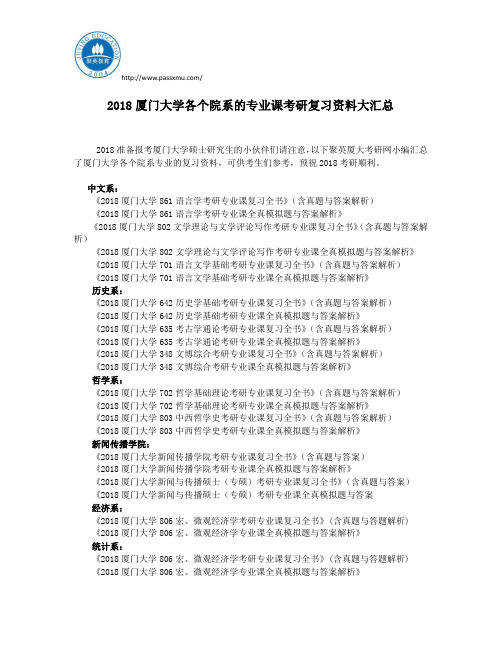
/2018厦门大学各个院系的专业课考研复习资料大汇总2018准备报考厦门大学硕士研究生的小伙伴们请注意,以下聚英厦大考研网小编汇总了厦门大学各个院系专业的复习资料,可供考生们参考,预祝2018考研顺利。
中文系:《2018厦门大学861语言学考研专业课复习全书》(含真题与答案解析)《2018厦门大学861语言学考研专业课全真模拟题与答案解析》《2018厦门大学802文学理论与文学评论写作考研专业课复习全书》(含真题与答案解析)《2018厦门大学802文学理论与文学评论写作考研专业课全真模拟题与答案解析》《2018厦门大学701语言文学基础考研专业课复习全书》(含真题与答案解析)《2018厦门大学701语言文学基础考研专业课全真模拟题与答案解析》历史系:《2018厦门大学642历史学基础考研专业课复习全书》(含真题与答案解析)《2018厦门大学642历史学基础考研专业课全真模拟题与答案解析》《2018厦门大学635考古学通论考研专业课复习全书》(含真题与答案解析)《2018厦门大学635考古学通论考研专业课全真模拟题与答案解析》《2018厦门大学348文博综合考研专业课复习全书》(含真题与答案解析)《2018厦门大学348文博综合考研专业课全真模拟题与答案解析》哲学系:《2018厦门大学702哲学基础理论考研专业课复习全书》(含真题与答案解析)《2018厦门大学702哲学基础理论考研专业课全真模拟题与答案解析》《2018厦门大学803中西哲学史考研专业课复习全书》(含真题与答案解析)《2018厦门大学803中西哲学史考研专业课全真模拟题与答案解析》新闻传播学院:《2018厦门大学新闻传播学院考研专业课复习全书》(含真题与答案)《2018厦门大学新闻传播学院考研专业课全真模拟题与答案解析》《2018厦门大学新闻与传播硕士(专硕)考研专业课复习全书》(含真题与答案)《2018厦门大学新闻与传播硕士(专硕)考研专业课全真模拟题与答案经济系:《2018厦门大学806宏、微观经济学考研专业课复习全书》(含真题与答题解析) 《2018厦门大学806宏、微观经济学专业课全真模拟题与答案解析》统计系:《2018厦门大学806宏、微观经济学考研专业课复习全书》(含真题与答题解析) 《2018厦门大学806宏、微观经济学专业课全真模拟题与答案解析》/《2018厦门大学868概率论与数理统计考研专业课复习全书》(含真题与答案解析)《2018厦门大学868概率论与数理统计考研专业课全真模拟题与答案解析》《2018厦门大学432统计学(专硕)考研专业课复习全书》(含真题与答案)《2018厦门大学432统计学(专硕)专业课全真模拟题与答案解析》《2018厦门大学432统计学考研专业课复习全书》(含真题与答案解析)《2018厦门大学432统计学考研专业课全真模拟题与答案解析》财政系:《2018厦门大学806宏、微观经济学考研专业课复习全书》(含真题与答题解析) 《2018厦门大学806宏、微观经济学专业课全真模拟题与答案解析》《2018厦门大学433税务专业基础考研专业课复习全书》(含真题与答案解析)《2018厦门大学433税务专业基础考研专业课全真模拟题与答案解析》《2018厦门大学436资产评估专业基础(专硕)考研专业课复习全书》(含真题与答案)《2018厦门大学436资产评估专业基础(专硕)考研专业课全真模拟题与答案解析》金融系:《2018厦门大学806宏、微观经济学考研专业课复习全书》(含真题与答题解析) 《2018厦门大学806宏、微观经济学专业课全真模拟题与答案解析》《2018厦门大学431金融学综合考研专业课复习全书》(含真题与答题解析)《2018厦门大学431金融学综合考研专业课全真模拟题与答案解析》《2018年版厦门大学435保险专业基础(专硕)考研专业课复习全书》《2018厦门大学435保险专业基础(专硕)考研专业课全真模拟题与答案解析》国际经济与贸易系:《2018厦门大学806宏、微观经济学考研专业课复习全书》(含真题与答题解析) 《2018厦门大学806宏、微观经济学专业课全真模拟题与答案解析》《2018厦门大学434国际商务专业基础原理考研专业课复习全书》(含真题与答案解析)《2018厦门大学434国际商务专业基础考研专业课全真模拟题与答案解析》经济研究所:《2018厦门大学806宏、微观经济学考研专业课复习全书》(含真题与答题解析) 《2018厦门大学806宏、微观经济学专业课全真模拟题与答案解析》宏观经济研究中心:《2018厦门大学806宏、微观经济学考研专业课复习全书》(含真题与答题解析) 《2018厦门大学806宏、微观经济学专业课全真模拟题与答案解析》王亚南经济研究院:《2018厦门大学868概率论与数理统计考研专业课复习全书》(含真题与答案解析)《2018厦门大学868概率论与数理统计考研专业课全真模拟题与答案解析》《2018厦门大学807经济学考研专业课复习全书》(含真题与答案解析)《2018厦门大学807经济学考研专业课全真模拟题与答案解析》《2018厦门大学806宏、微观经济学考研专业课复习全书》(含真题与答案解析)《2018厦门大学432统计学考研专业课复习全书》(含真题与答案解析)/《2018厦门大学432统计学考研专业课全真模拟题与答案解析》《2018厦门大学431金融学综合考研专业课复习全书》(含真题与答案解析)《2018厦门大学431金融学综合考研专业课全真模拟题与答案解析》《2018厦门大学432统计学(专硕)考研专业课复习全书》(含真题与答案)《2018厦门大学432统计学(专硕)专业课全真模拟题与答案解析》中国能源经济研究中心:《2018厦门大学806宏、微观经济学考研专业课复习全书》(含真题与答题解析) 《2018厦门大学806宏、微观经济学专业课全真模拟题与答案解析》会计系:《2018厦大808管理学与管理经济学专业课复习全书》《2018厦门大学808管理学与管理经济学专业课全真模拟题与答案解析》企业管理系:《2018厦大808管理学与管理经济学专业课复习全书》《2018厦门大学808管理学与管理经济学专业课全真模拟题与答案解析》管理科学系:《2018厦门大学809运筹学考研专业课复习全书》《2018厦门大学809运筹学专业课全真模拟题与答案解析》《2018厦大808管理学与管理经济学专业课复习全书》《2018厦门大学808管理学与管理经济学专业课全真模拟题与答案解析》旅游与酒店管理系:《2018厦大808管理学与管理经济学专业课复习全书》《2018厦门大学808管理学与管理经济学专业课全真模拟题与答案解析》财务学系:《2018厦大808管理学与管理经济学专业课复习全书》《2018厦门大学808管理学与管理经济学专业课全真模拟题与答案解析》市场学系:《2018厦大808管理学与管理经济学专业课复习全书》《2018厦门大学808管理学与管理经济学专业课全真模拟题与答案解析》法学院:《2018厦门大学法学院考研专业课复习全书》(含真题与答案)《2018厦门大学法学院考研专业课全真模拟题与答案解析》知识产权研究院:《2018厦门大学法学院考研专业课复习全书》(含真题与答案)《2018厦门大学法学院考研专业课全真模拟题与答案解析》《2018厦门大学810民法学和刑法学考研专业课复习全书》(含真题与答案解析)《2018厦门大学810民法学和刑法学考研专业课全真模拟题与答案解析》政治学系:《2018厦门大学706政治学与公共管理学考研专业课复习全书》(含真题与答案解析)/《2018厦门大学706政治学与公共管理学考研专业课全真模拟题与答案解析》公共管理系:《2018厦门大学812政策科学与经济学考研专业课复习全书》(含真题与答题解析) 《2018厦门大学812政策科学与经济学考研专业课全真模拟题与答案解析》《2018厦门大学706政治学与公共管理学考研专业课复习全书》(含真题与答案解析) 《2018厦门大学706政治学与公共管理学考研专业课全真模拟题与答案解析》社会学系:《2018厦门大学707社会学原理考研专业课复习全书》(含真题与答题解析)《2018厦门大学707社会学原理考研专业课全真模拟题与答案解析》《2018厦门大学813社会调查研究方法考研专业课复习全书》(含真题与答题解析) 《2018厦门大学813社会调查研究方法考研专业课全真模拟题与答案解析》《2018厦门大学437社会工作实务考研专业课复习全书》(含真题与答案解析)《2018厦门大学437社会工作实务考研专业课全真模拟题与答案解析》《2018厦门大学331社会工作原理考研专业课复习全书》(含真题与答案解析)《2018厦门大学331社会工作原理考研专业课全真模拟题与答案解析》人口研究所:《2018厦门大学707社会学原理考研专业课复习全书》(含真题与答题解析)《2018厦门大学707社会学原理考研专业课全真模拟题与答案解析》《2018厦门大学813社会调查研究方法考研专业课复习全书》(含真题与答题解析) 《2018厦门大学813社会调查研究方法考研专业课全真模拟题与答案解析》马克思主义学院:《2018厦门大学866中国化的马克思主义考研专业课复习全书》(含真题与答案解析)《2018厦门大学866中国化的马克思主义考研专业课全真模拟题与答案解析》《2018厦门大学638马克思主义基本原理考研专业课复习全书》(含真题与答案解析)《2018厦门大学638马克思主义基本原理考研专业课全真模拟题与答案解析》公共政策研究院:《2018厦门大学806宏、微观经济学考研专业课复习全书》(含真题与答题解析)《2018厦门大学806宏、微观经济学专业课全真模拟题与答案解析》《2018厦门大学812政策科学与经济学考研专业课复习全书》(含真题与答题解析) 《2018厦门大学812政策科学与经济学考研专业课全真模拟题与答案解析》《2018厦门大学706政治学与公共管理学考研专业课复习全书》(含真题与答案解析) 《2018厦门大学706政治学与公共管理学考研专业课全真模拟题与答案解析》英语语言文学系:《2018厦门大学708写作与英汉互译考研专业课复习全书》(含真题与答案)《2018厦门大学708写作与英汉互译考研专业课全真模拟题与答案解析》《2018厦门大学814阅读及英美文学、语言学基础考研专业课复习全书》(含真题与答案解析)《2018厦门大学814阅读及英美文学、语言学基础考研专业课全真模拟题与答案解析》/《2018厦门大学357英语翻译基础考研专业课复习全书》(含真题与答案解析)《2018厦门大学357英语翻译基础考研专业课全真模拟题与答案解析》《2018厦门大学211翻译硕士英语考研专业课复习全书》(含真题与答案解析)《2018厦门大学211翻译硕士英语考研专业课全真模拟题与答案解析》欧洲语言文学系:《2018厦门大学241英语(二外)考研专业课复习全书》(含真题与答案解析)《2018厦门大学241英语(二外)考研专业课全真模拟题与答案解析》外语教学部:《2018厦门大学708写作与英汉互译考研专业课复习全书》(含真题与答案)《2018厦门大学708写作与英汉互译考研专业课全真模拟题与答案解析》《2018厦门大学814阅读及英美文学、语言学基础考研专业课复习全书》(含真题与答案解析)《2018厦门大学814阅读及英美文学、语言学基础考研专业课全真模拟题与答案解析》日语语言文学系:《2018厦门大学241英语(二外)考研专业课复习全书》(含真题与答案解析)《2018厦门大学241英语(二外)考研专业课全真模拟题与答案解析》法语语言文学系:《2018厦门大学241英语(二外)考研专业课复习全书》(含真题与答案解析)《2018厦门大学241英语(二外)考研专业课全真模拟题与答案解析》音乐系:《2018厦门大学818艺术概论考研专业课复习全书》(含真题与答案解析)《2018厦门大学818艺术概论考研专业课全真模拟题与答案解析》《2018厦门大学614中外音乐史考研专业课复习全书》(含真题与答案解析)《2018厦门大学614中外音乐史考研专业课全真模拟题与答案解析》美术系:《2018厦门大学818艺术概论考研专业课复习全书》(含真题与答案解析)《2018厦门大学818艺术概论考研专业课全真模拟题与答案解析》《2018厦门大学612中外美术史考研专业课复习全书》(含真题与答案解析)《2018厦门大学612中外美术史考研专业课全真模拟题与答案解析》物理系:《2018厦门大学820量子力学考研专业课复习全书》(含真题与答案)《2018厦门大学615普通物理学(含热、力、光、电)考研专业课复习全书》(含真题与答案)航空系:《2018厦门大学824机械设计基础考研专业课复习全书》(含真题与答案)《2018厦门大学823工程力学考研专业课复习全书》(含真题与答案)《2018厦门大学822微机原理考研专业课复习全书》(含真题与答案)电子科学系:/《2018厦门大学847信号与系统考研专业课复习全书》(含真题与答案解析)《2018厦门大学846电子线路(含模拟和数字)考研专业课复习全书》(含真题与答案解析)电磁声学研究院:《2018厦门大学847信号与系统考研专业课复习全书》(含真题与答案解析)《2018厦门大学615普通物理学(含热、力、光、电)考研专业课复习全书》(含真题与答案)数学科学学院:《2018厦门大学825高等代数考研专业课复习全书》(含真题与答案解析)《2018厦门大学825高等代数考研专业课全真模拟题与答案解析》《2018厦门大学616数学分析考研专业课复习全书》(含真题与答案)《2018厦门大学616数学分析考研专业课全真模拟题与答案解析》化学系:《2018厦门大学832生物化学考研专业课复习全书》(含真题与答案解析)《2018厦门大学832生物化学考研专业课全真模拟题与答案解析》《2018厦门大学827分析化学(含仪器分析)考研专业课复习全书》(含真题与答案解析)《2018厦门大学827分析化学(含仪器分析)考研专业课全真模拟题与答案解析》《2018厦门大学820量子力学考研专业课复习全书》(含真题与答案)《2018厦门大学615普通物理学(含热、力、光、电)考研专业课复习全书》(含真题与答案)生物材料系:《2018厦门大学832生物化学考研专业课复习全书》(含真题与答案解析)《2018厦门大学832生物化学考研专业课全真模拟题与答案解析》生命科学学院:《2018厦门大学620分子细胞生物学专业课复习全书》(含真题与答案解析)《2018厦门大学832生物化学考研专业课全真模拟题与答案解析》《2018厦门大学832生物化学专业课复习全书》(含真题与答案解析)《2018厦门大学832生物化学专业课全真模拟题与答案解析》海洋与地球学院:《2018厦门大学832生物化学考研专业课复习全书》(含真题与答案解析)《2018厦门大学832生物化学考研专业课全真模拟题与答案解析》《2018厦门大学620分子细胞生物学专业课复习全书》(含真题与答案解析)《2018厦门大学615普通物理学(含热、力、光、电)考研专业课复习全书》(含真题与答案)环境与生态学院:《2018厦门大学833分析化学考研专业课复习全书》(含真题与答案解析)《2018厦门大学833分析化学考研专业课全真模拟题与答案解析》/海洋与海岸带发展研究院:《2018厦门大学706政治学与公共管理学考研专业课复习全书》(含真题与答案解析) 《2018厦门大学706政治学与公共管理学考研专业课全真模拟题与答案解析》电子工程系:《2018厦门大学845数据结构考研专业课复习全书》(含真题与答案解析)《2018厦门大学845数据结构考研专业课全真模拟题与答案解析》通信工程系:《2018厦门大学847信号与系统考研专业课复习全书》(含真题与答案解析)医学院:《2018厦门大学832生物化学考研专业课复习全书》(含真题与答案解析)《2018厦门大学832生物化学考研专业课全真模拟题与答案解析》建筑系:《2018厦门大学355建筑学基础考研专业课复习全书》(含真题与答案解析)《2018厦门大学355建筑学基础考研专业课全真模拟题与答案解析》南洋研究院:《2018厦大808管理学与管理经济学专业课复习全书》《2018厦门大学808管理学与管理经济学专业课全真模拟题与答案解析》《2018厦门大学642历史学基础考研专业课复习全书》(含真题与答案解析)《2018厦门大学642历史学基础考研专业课全真模拟题与答案解析》《2018厦门大学858国际关系史考研专业课复习全书》(含真题与答案解析)《2018厦门大学858国际关系史考研专业课全真模拟题与答案解析》《2018厦门大学806宏、微观经济学考研专业课复习全书》(含真题与答案解析)《2018厦门大学806宏、微观经济学考研专业课全真模拟题与答案解析》《2018厦门大学630国际政治考研专业课复习全书》(含真题与答案解析)《2018厦门大学630国际政治考研专业课全真模拟题与答案解析》台湾研究院:《2018厦门大学642历史学基础考研专业课复习全书》(含真题与答案解析)《2018厦门大学642历史学基础考研专业课全真模拟题与答案解析》《2018厦门大学811现代政治思想(中、西)考研专业课复习全书》(含真题与答题解析)《2018厦门大学811现代政治思想(中、西)考研专业课全真模拟题与答案解析》《2018厦门大学706政治学与公共管理学考研专业课复习全书》(含真题与答案解析) 《2018厦门大学706政治学与公共管理学考研专业课全真模拟题与答案解析》《2018厦门大学642历史学基础考研专业课复习全书》(含真题与答案解析)《2018厦门大学642历史学基础考研专业课全真模拟题与答案解析》《2018厦门大学701语言文学基础考研专业课复习全书》(含真题与答案解析)《2018厦门大学701语言文学基础考研专业课全真模拟题与答案解析》《2018厦门大学810民法学和刑法学考研专业课复习全书》(含真题与答案解析)/《2018厦门大学802文学理论与文学评论写作考研专业课复习全书》(含真题与答案解析)《2018厦门大学802文学理论与文学评论写作专业课全真模拟题与答案解析》《2018厦门大学806宏、微观经济学考研专业课复习全书》(含真题与答题解析)《2018厦门大学806宏、微观经济学专业课全真模拟题与答案解析》教育研究院:《2018厦门大学641心理学专业基础综合考研专业课复习全书》(含真题与答案解析)《2018厦门大学641心理学专业基础综合考研专业课全真模拟题与答案解析》《2018厦门大学640教育学专业基础综合考研专业课复习全书》(含真题与答案解析)《2018厦门大学640教育学专业基础综合考研专业课全真模拟题与答案解析》药学院:《2018厦门大学832生物化学考研专业课复习全书》(含真题与答案解析)《2018厦门大学832生物化学考研专业课全真模拟题与答案解析》《2018厦门大学827分析化学(含仪器分析)考研专业课复习全书》(含真题与答案解析)《2018厦门大学827分析化学(含仪器分析)考研专业课全真模拟题与答案解析》《2018厦门大学826物理化学考研专业课复习全书》《2018厦门大学619有机化学考研专业课复习全书》(含真题与答案)《2018厦门大学617无机化学考研专业课复习全书》(含真题与答案)《2018厦门大学824机械设计基础考研专业课复习全书》(含真题与答案)《2018厦门大学823工程力学考研专业课复习全书》(含真题与答案)《2018厦门大学822微机原理考研专业课复习全书》(含真题与答案)海外教育学院:《2018厦门大学640教育学专业基础综合考研专业课复习全书》(含真题与答案解析)《2018厦门大学640教育学专业基础综合考研专业课全真模拟题与答案解析》《2018厦门大学701语言文学基础考研专业课复习全书》(含真题与答案解析)《2018厦门大学701语言文学基础考研专业课全真模拟题与答案解析》《2018厦门大学703新闻学与传播学基础考研专业课复习全书》(含真题与答案解析)《2018厦门大学703新闻学与传播学基础考研专业课全真模拟题与答案解析》《2018厦门大学861语言学考研专业课复习全书》(含真题与答案解析)《2018厦门大学861语言学考研专业课全真模拟题与答案解析》《2018厦门大学354汉语基础考研专业课复习全书》(含真题与答案解析)《2018厦门大学354汉语基础考研专业课全真模拟题与答案解析》《2018厦门大学新闻传播学院考研专业课复习全书》(含真题与答案)《2018厦门大学新闻传播学院考研专业课全真模拟题与答案解析》《2018厦门大学445汉语国际教育基础考研专业课全真模拟题与答案解析》能源学院:/《2018厦门大学846电子线路(含模拟和数字)考研专业课复习全书》(含真题与答案解析)《2018厦门大学846电子线路(含模拟和数字)考研专业课全真模拟题与答案解析》《2018厦门大学845数据结构考研专业课复习全书》(含真题与答案解析)《2018厦门大学845数据结构考研专业课全真模拟题与答案解析》《2018厦门大学832生物化学考研专业课复习全书》(含真题与答案解析)《2018厦门大学832生物化学考研专业课全真模拟题与答案解析》《2018厦门大学826物理化学考研专业课复习全书》《2018厦门大学829材料科学基础考研专业课复习全书》(含真题与答案)《2018厦门大学844自动控制原理专业课复习全书》(含真题与答案)财务管理与会计研究院:《2018厦大808管理学与管理经济学专业课复习全书》《2018厦门大学808管理学与管理经济学专业课全真模拟题与答案解析》公共卫生学院:《2018厦门大学847信号与系统考研专业课复习全书》(含真题与答案解析)《2018厦门大学832生物化学考研专业课复习全书》(含真题与答案解析)《2018厦门大学832生物化学考研专业课全真模拟题与答案解析》《2018厦门大学827分析化学(含仪器分析)考研专业课复习全书》(含真题与答案解析)《2018厦门大学826物理化学考研专业课复习全书》《2018厦门大学619有机化学考研专业课复习全书》(含真题与答案)《2018厦门大学617无机化学考研专业课复习全书》(含真题与答案)《2018厦门大学824机械设计基础考研专业课复习全书》(含真题与答案)《2018厦门大学823工程力学考研专业课复习全书》(含真题与答案)《2018厦门大学822微机原理考研专业课复习全书》(含真题与答案)《2018厦门大学827分析化学(含仪器分析)考研专业课全真模拟题与答案解析》萨本栋微米纳米科学技术研究院:《2018厦门大学846电子线路(含模拟和数字)考研专业课复习全书》(含真题与答案解析)《2018厦门大学846电子线路(含模拟和数字)考研专业课全真模拟题与答案解析》《2018厦门大学832生物化学考研专业课复习全书》(含真题与答案解析)《2018厦门大学832生物化学考研专业课全真模拟题与答案解析》《2018厦门大学826物理化学考研专业课复习全书》《2018厦门大学824机械设计基础考研专业课复习全书》(含真题与答案)《2018厦门大学823工程力学考研专业课复习全书》(含真题与答案)《2018厦门大学822微机原理考研专业课复习全书》(含真题与答案)《2018厦门大学829材料科学基础考研专业课复习全书》(含真题与答案)《2018厦门大学820量子力学考研专业课复习全书》(含真题与答案)。
【免费下载】厦门大学研究生入学考试历年真题及答案
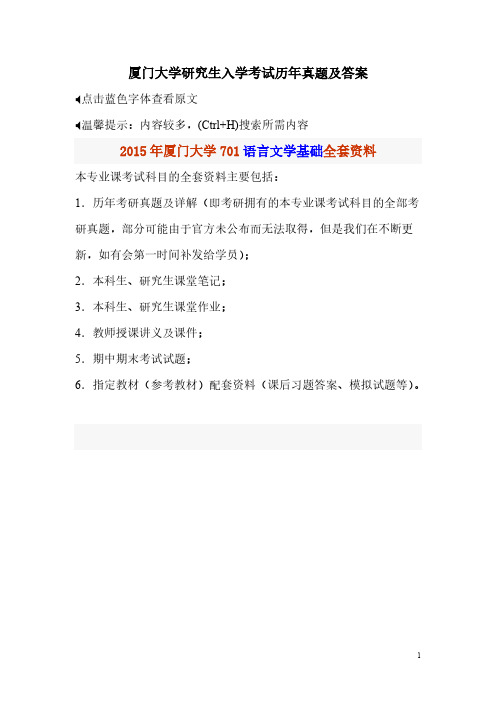
厦门大学研究生入学考试历年真题及答案点击蓝色字体查看原文温馨提示:内容较多,(Ctrl+H)搜索所需内容2015年厦门大学701语言文学基础全套资料本专业课考试科目的全套资料主要包括:1.历年考研真题及详解(即考研拥有的本专业课考试科目的全部考研真题,部分可能由于官方未公布而无法取得,但是我们在不断更新,如有会第一时间补发给学员);2.本科生、研究生课堂笔记;3.本科生、研究生课堂作业;4.教师授课讲义及课件;5.期中期末考试试题;6.指定教材(参考教材)配套资料(课后习题答案、模拟试题等)。
2015年厦门大学802文学理论与文学评论写作全套资料本专业课考试科目的全套资料主要包括:1.历年考研真题及详解(即考研拥有的本专业课考试科目的全部考研真题,部分可能由于官方未公布而无法取得,但是我们在不断更新,如有会第一时间补发给学员);2.本科生、研究生课堂笔记;3.本科生、研究生课堂作业;4.教师授课讲义及课件;5.期中期末考试试题;6.指定教材(参考教材)配套资料(课后习题答案、模拟试题等)。
2015年厦门大学861语言学全套资料本专业课考试科目的全套资料主要包括:1.历年考研真题及详解(即考研拥有的本专业课考试科目的全部考研真题,部分可能由于官方未公布而无法取得,但是我们在不断更新,如有会第一时间补发给学员);2.本科生、研究生课堂笔记;3.本科生、研究生课堂作业;4.教师授课讲义及课件;5.期中期末考试试题;6.指定教材(参考教材)配套资料(课后习题答案、模拟试题等)。
2015年厦门大学313历史学基础全套资料本专业课考试科目的全套资料主要包括:1.历年考研真题及详解(即考研拥有的本专业课考试科目的全部考研真题,部分可能由于官方未公布而无法取得,但是我们在不断更新,如有会第一时间补发给学员);2.本科生、研究生课堂笔记;3.本科生、研究生课堂作业;4.教师授课讲义及课件;5.期中期末考试试题;6.指定教材(参考教材)配套资料(课后习题答案、模拟试题等)。
厦门大学英语专业考研真题---2004阅读及英美文学、语言学

2004年招生专业英语语言文学考试课程阅读及英美文学、语言学417Part One Reading Comprehension70pointsDirections:Each passage is followed by questions based on its content.After reading the passage,choose the best answer to each question.Answer all questions following the passage on the basis of what is stated or implied in that passage.Passage1The tap dancer,like the flamenco performer,is basically an improviser.Thus looking at tap one wants to savor the personality and inventiveness of the individual.When Bill Robinson danced in the movies,his technical skill and sophisticated rhythms could be heard as well as seen.The Nicholas Brothers ran up walls or the proscenium arch of the theater or jumped off platforms and landed in splits on the floor.Peg Leg Bates,who had lost a leg,made a specialty out of dancing with his wooden leg.Sandman Sims scattered sand on the floor(as Fred Astaire did in one of his films) and tapped ever so softly,slid and turned in dances as soothing as lullabies.1.What does the passage mainly discuss?(A)The styles of various tap dancers(B)The structure of the modern dance theater(C)The difference between flamenco and tap dancing(D)The use of dance in certain movie productions2.According to the passage,in what way is a flamenco dancer similar to a tap dancer?(A)Both perform the same kinds of steps(B)Both rely on individual inventiveness(C)Both are trained in classical techniques(D)Both make very little noise3.An acrobatic style of dancing was most closely associated with which of the following performers?(A)Peg Leg Bates(B)Bill Robinson(C)The Nicholas Brothers(D)Sims and Astaire4.Which two dancers used sand in their routines?(A)Robinson and Sims(B)The Nicholas Brothers(C)Bates and Robinson(D)Sims and Astaire5.The author implies which of the following about tap dancing?(A)It is more complex than flamenco dancing(B)It is meant to be heard as well as seen(C)It became popular primarily because of the movies(D)It should be performed by at least two people.Passage2The science of meteorology is concerned with the study of the structure,state,and behavior of the atmosphere.The subject may be approached from several directions,but the scene cannot be fully appreciated from any advantage point.Different views must be integrated to give perspective to the whole picture.One may consider the condition of the atmosphere at a given moment and attempt to predict changes from that condition over a period of a few hours to a few days ahead.This approach is covered by the branch of the science called synoptic(天气的)meteorology.Synoptic meteorology is the scientific basis of the technique of weather forecasting by means of the preparation and analysis of weather maps and aerological diagram.The practical importance of the numerous applications of weather forecasting cannot be overestimated.In serving the needs of shipping,aviation,agriculture,industry,and many other interests and fields of human activity with accurate weather warnings and professional forecast advice,great benefits are reaped in the form of the saving of human life and property and in economic advantages of various kinds.One important purpose of the science of meteorology is constantly to strive,through advanced study and research,to increase our knowledge of the atmosphere with the aim of improving the accuracy of weather forecasts.The tools needed to advance our knowledge in this way are the disciplines of mathematics and physics applied to solve meteorological problems.The use of these tools forms that branch of the science called dynamic meteorology.6.Which of the following is the best title for the passage?A)The Limitations of Meteorological ForecastingB)New Advances in Synoptic MeteorologyC)Approaches to the Science of MeteorologyD)The Basics of Dynamic Meteorology7.The prediction of synoptic meteorologists are directly based on the____(A)application of the physical sciences(B)preparation and study of weather maps(C)anticipated needs of industry(D)observations of commercial airline pilots8.Which of the following is NOT referred to by the author as a field whose needs are served by weather forecasting?A)Transportation.B)Manufacturing. C)Farming.D)Sports.9.The author implies that increased accuracy in weather forecasting will lead to____.A)more funds allocated to meteorological researchB)greater protection of human lifeC)a higher number of professional forecastersD)less-specialized forms of synoptic meteorology10.Which of the following statements best describes the organization of the third paragraph of the passage?A)A procedure is explained and its importance is emphasized.B)Two contrasting views of a problem are presented.C)Recent scientific advancements are outlined in order of importance.D)A problem is examined and possible solutions are given.11.In the last sentence of the passage,the phrase“these tools”refers to____.A)weather forecastsB)meteorological problemsC)mathematics and physicsD)economic advantagePassage3There are three basic ways in which individual economic units interact with one another.They are the market system,the administered system, and the traditional system.In a market system,individual economic units are free to interact among each other in the market place.Transactions may take place through barter or money exchange.In a barter economy,real goods such as automobiles,shoes,and pizzas are traded against each other.Obviously,finding somebody who wants to trade an old car in exchange for a sailboat may not always be an easy task.Hence the introduction of money as a medium of exchange eases transactions considerably.An alternative to the market system is administered control by some agency over all transactions.This agency will issue laws or commands as to how much each goods and service should be produced,exchanged,and consumed by each economic unit.Central planning may be one way of administering such an economy.The central plan drawn up by the government shows the amount of each commodity produced by the various firms and distributed to different households for consumption.In a traditional society,production and consumption patterns are governed by tradition.Each person′s place with the economic system is fixed by parentage,religion,and custom.Transactions take place on the basis of tradition,too.People belonging to a certain group or caste may have an obligation to care for other persons,provide them with food and shelter,care for their health,and provide for their education.Clearly,in a system where every decision is made on the basis of tradition alone progress may be difficult to achieve.12.What is the main purpose of the passage?A)To explain the science of economics.B)To outline types of economic systems.C)To argue for the superiority of one economic system.D)To compare barter and money exchange markets.13.In the second paragraph,by which of the following could the word"real"best be replaced?A)High quality.B)Concrete.C)Utter.D)Essential.14.According to the passage,a barter economy can lead toA)rapid speed of transactionsB)misunderstandingsC)inflationD)difficulties for the traders15.According to the passage who has the greatest degree of control on an administered system?A)Individual households.B)Small businesses.C)Major companies.D)The government.Passage4What is the future for cities?Why does one inner-city neighborhood become a slum and another a high-class district?Why does one city attract new shopper and visitors while another languishes?Camden,New Jersey,displays the strong contrast that characterize American urban areas.The central city of Camden houses an isolated underclass., while suburban Camden County prospers.The population of the city of Camden has declined from117,000in1960to less than80,000today.Nearly 85percent of the city’s residents are black and Hispanic,while the white population has declined from90,000in1960to10,000today.Only1 percent of the households remaining have annual incomes of more than$50,000,compared with20percent in the rest of the country and10percent among all black households.More than40percent of Camden’s residents are under eighteen,closer to the level found in developing countries than to eh rest of the United States.Job prospects are not promising for these young people,because more than half have left school without obtaining a high-school diploma.In the past,Camden’s youths could find jobs in factories that produced Campbell’s soups,Esterbrook pens,and RCA Victor records,radios,and televisions,but the city has lost90percent of its industrial jobs.The Esterbrook and Campbell factories in Camden are closed,though Campbell’s corporate offices remain:General Electric now operates the former RCA factory but with a labor force at only15percent of the level during the 1960s.Camden’s unemployment rate is more than twice the national average.As Camden’s population and industries decline,few shops have enough customers to remain open.The city once had thirteen movie theaters, but none are left.The murder rate soared after gangs carved up the city into districts during the mid-1980s to control cocaine trafficking.Meanwhile,Camden County–excluding the city–has grown from275,000in1960to more than400,000today.Cherry Hill has more than 75,000residents today,compared to less than10,000in1960,and will surpass Camden as the largest city in the county before the end of the decade. About85percent of Cherry Hill’s high-school graduates go on to college.Cherry Hill has attracted so many new jobs that the major obstacles to further economic growth is a shortage of qualified workers.Camden’s mismatch between the locations of people,jobs,resources,and services exemplifies the urban crisis throughout the United States,as well as in other countries.Geographers help us to understand why these patterns arise,and what be done about them.16.Which of the following is NOT TRUE?A)Camden County is larger than the city of Camden.B)Cherry Hill’s economy is sluggishC)The white people have moved to the suburbs.D)General Electric now employs less workers than it used to.17.What is the author most likely to do in the following section?A)Elaborating on geographical patterns of other areas.B)Quoting government policies in favor of her view.C)Highlighting statistics in support of her argument.D)Proposing possible solutions to the problem.Passage5For a long time we have worked hard at isolating the individual family.This has increased the mobility of individuals;and by encouraging young families to break away from older generations and the home community,we have burdened every small family with tremendous responsibilities once shared within three generations and among a large number of people–the nurturing of small children,the initiation of adolescents into adulthood,and care of the sick and disabled and the protection of the aged.What we have failed to realize to realize is that even as we have separated the single family from the larger society,we have expected each couple to take on a range of obligations that traditionally have been shared within a family and a wilder community.So all over the world there are millions of families left alone,as it were,each in its own box–parents faced with the specter of what may happen if either one gets sick,children fearful that their parents may end their quarrels with divorce,and empty-handed old people without any role in the life of the next generation.Then,having reduced little by little to almost nothing the relationship between families the community,when families get into trouble because they cannot accomplish the impossible,we turn their problems over to impersonal social agencies,which can act only in a fragmented way because they are limited to patchwork programs that often are too late to accomplish what is most needed.Individuals and families do get some kind of help,but what they learn and what those who work hard within the framework of social agencies convey,even as they try to help,is that families should be able to care for themselves.18.According to the author,when young families are isolated,______A)old people can easily accept the change B)people can move from place to placeC)individuals can hardly become innovative D)economy develops at high speed19.What is said to be the major problem facing young couples?A)They need to be fulfill more dutiesB)They are incapable of balancing the budgetC)They have their children spoiled and overindulgedD)They get empty-handed after divorce.20.The author implies that________.A)social agencies in America can be very helpfulB)the help of American families from social agencies is limited.C)the government should do more to improve patchwork programs.D)the fragmentary nature of the American family is unique.Passage6Throughout human history there have been many stringent taboos concerning watching other people eat or eating in the presence of others. There have been attempts to explain these taboos in terms of inappropriate social relationships either between those who are involved and those who are not simultaneously involved in the satisfaction of a bodily need,or between those already satiated and those who appear to be shamelessly gorging.Undoubtedly such elements exist in the taboos,but there is an additional element with a much more fundamental importance.In prehistoric times,when food was so precious and the on-lookers so hungry,not to offer half of the little food one had was unthinkable,since every glance was a plea for life.Further,during those times,people existed in nuclear or extended family groups,and the sharing of food was quite literally supporting one’s family or,by extension,preserving one’s self.21.If the argument in the passage is valid,taboos against eating in the presence of others who are not also eating would be LEAST likely in a societythat(A)always had a plentiful supply of food(B)emphasized the need to share worldly goods(C)emphasized the value of privacy(D)discouraged overindulgence22.According to the passage,the author believes that past attempts to explain some taboos concerning eating are(A)implausible(B)incomplete(D)ill-founded(D)inelegantPassage7Air,like words,is a form of communication.Words,spoken and written,render accessible to humans of the latest generations all the knowledge discovered by the experience and reflection,both of preceding generations and of the best and foremost minds of their own times.Art renders accessible to people of the latest generations all the feelings experienced by their predecessors,and those already felt by their best and foremost contemporaries.Just as the proceeds through art.Feelings less kind and less necessary for the well-being of humankind are replaced by other kinder and more essential to that end.This is the purpose of art,and the more art fulfills that purpose that better the art;the less it fulfills it,the worse the art.23.The author develops the passage primarily by____(A)theory and refutation(B)example and generalization(C)question and answer(D)inference and deduction24.According to the author,knowledge is____(A)evolutionary and emotional(B)cumulative and progressive(C)static and unmoving(D)dynamic and cyclical25.The style of the passage can best be described as_____(A)speculative(B)argumentative(D)expository(D)sarcasticPassage8Our current system of unemployment compensation has increased nearly all sources of adult unemployment seasonal and cyclical variations in the demand for labor,weak labor force attachment,and unnecessarily long durations of unemployment.First,for those who are already unemployed, the system greatly reduces the cost of extending the period of unemployment.Second,for all types of unsteady work–seasonal,cyclical and casual –it raises the net wage to the employee,relative to the cost of the employer.As for the first,consider a worker who earns$500per month or$6000per year if she experiences no employment.If she is unemployed for one month,she loses$500in gross earnings but only$116in net income.How does this occur?A reduction of$500in annual earning reduces her federal,payroll and state tax liability by$134.Unemployment compensation consists of50percent of her wage or$250.Her net income therefore falls from$366if is employed,to$250paid as unemployment compensation.Moreover,part of the higher income from employment is offset by the cost of transportation to work and other expenses associated with employment;and in some industries,the cost of unemployment is reduced further or even made negative by the supplementary unemployment benefits paid by employers under collective bargaining agreements.The overall effect is to increase the duration of a typical spell of unemployment and to increase the frequency with which individuals lose jobs and become unemployed.The more general effect of unemployment compensation is to increase the seasonal and cyclical fluctuations in the demand for labor and the relative number of short-lived casual jobs.A worker who accepts such work knows she will be laid off when the season ends.If there were no unemployment compensation,workers could be induced to accept such unstable jobs only if the wage rate were sufficiently higher in those jobs than in the more stable alternative.The higher cost of labor,then would induce employers to reduce the instability of employment by smoothing production lags,by additional development of off-season work and by the introduction of new production techniques,e.g.new methods of outdoor work in bad weather.Employers contribute to the state unemployment compensation fund on the basis of their own previous employers.Within limits,the more benefits that those former employees draw,the higher is the employer’s tax rate.The theory of experience rating is clear.If an employer paid the full cost of the unemployment benefits that his former employees received,unemployment compensation would provide no incentive to an excess use of unstable unemployment.In practice,however,experience rating is limited by a maximum rate of employer contribution.For any firm which pays the maximum rate,there is no cost for additional unemployment and no gain from a small reduction in unemployment.The challenge at this time is to restructure the unemployment system in a way that strengthens its good features while reducing the harmful distinctive effects.Some gains can be achieved by removing the ceiling on the employer’s rate of contribution and by lowering the minimum rate to zero.Employers would then pay the full price of unemployment insurance benefits were taxed in the same way as other earnings.This would eliminate the anomalous situations in which a worker’s net income is actually reduced when he returns to work.26.The author’s primary concern is to_______(A)defend the system of unemployment compensation against criticism(B)advocate expanding the benefits and scope of coverage of unemployment compensation(C)point to weakness inherent in government programs which subsidize individuals(D)suggest reform to eliminate inefficiencies in unemployment compensation27.The author cites the example of a worker earning$500per month in order to______(A)show the disincentive created by unemployment compensation for that worker to return to work(B)demonstrate that the employers do not bear the full cost of worker compensation(C)condemn workers who prefer to live on unemployment compensation to taking a job(D)explain why employers prefer to hire seasonal workers instead of permanent workers for short-term jobs28.The author mentions all of the following as ways by which employers might reduce seasonal and cyclical unemployment EXCEPT_______(A)developing new techniques of production not affected by weather(B)slowing delivery schedules to provide work during slow seasons(C)adopting a system of supplementary benefits for workers laid of in slow periods(D)finding new jobs to be done by workers during the off-season.29.With which of the following statements about experience rating would the author most likely agree?(A)Experience rating is theoretically sound,but its effectiveness in practice in undermined by maximum contribution ceilings(B)Experience rating is an inefficient method of computing employer contribution because an employer has no control over the length of anemployee’s unemployment(C)Experience rating is theoretically invalid and should be replaced by a system in which the employee contributes the full amount of benefits hewill later receive.(D)Experience rating is basically fair,but its performance could be improved by requiring large firms to pay more than small firms.30.It can be inferred that the author regards the unemployment compensation system is______(A)socially necessary(B)economically efficient(C)inherently wasteful(D)seriously outdatedPassage9In the past,evolutionary biologists contemplating the absence of wheels in nature agreed that the explanation was not undesirability;wheels would be good for animals,just as they are for us.Animals were prevented from evolving wheels,the biologists reasoned,by the following dilemma: Living cells in an animal’s body are connected to the heart by blood vessels,and to the brain by nerves.Because a rotating joint is essential to a wheel,a wheel made of living cells would twist its artery,vein,and nerve connections at the first revolution,making living wheels impracticable.However,there is a flaw in the argument that the evolution of wheeled animals was thwarted by the insoluble joint problem.The theory fails to explain why animals have not evolved wheels of dead tissue with no need for arteries and nerves.Countless animals,including us,bear external structures without blood supply or nerves–for example,our hair and fingernails,or the scales,claws,and horns of other animals.Why have rats not evolved bony wheels,similar to roller skates?Paws might be more useful than wheels in some situations,but cat’s claws are retractable;why not retractable wheels?We thus arrive at the serious biological paradox flippantly termed the RRR dilemma:nature’s failure to produce rats with retractable roller skates.31.Which of the following is the best title for the passage?(A)Evolutionary Biology:New Research Methods(B)How Do Living Joints Function?(C)Wheels for Animals:A Biological Possibility?(D)The Evolutionary History of The Wheel32.The passage discusses the evolution of animals in terms of their______(A)genetic structures(B)reproductive cycles(C)anatomy(D)behavior33.The structural material of the wheels discussed in the passage in would be similar to that of______(A)nerves(B)joints(C)arteries and veins(D)scales and horns34.The concept of retractable roller skates,mentioned in the last sentence,would be best explained as______(A)an evolutionary variation of claws(B)a complex structure of living tissue(C)an example of human intervention in natural development(D)a new discovery by evolutionistsPassage10When the persuading and the planning for the western railroads had finally been completed,the really challenging task remained:the dangerous,sweaty,backbreaking,brawling business of actually building the lines.The men who took it on comprised the most cosmopolitan work crew in American history.They included Civil War veterans and freed slaves,Irish and German immigrants,Mormons and atheists,Shoshonis, Paiutes,Washos,and Chinese.At the peak of their labors,the work crews laid two to five miles of track a day.The men filled ravines,ran spidery trestles across rivers and valleys,and punched holes through mountains.And they did all these jobs largely by their own muscle power.Flatcars carried rails to within half a mile of the railhead;there the iron was loaded onto carts.An eyewitness described the procedure:“A light car,drawn by a single horse,gallops up to the front with its load rails.Two men seize the end of a rail and start forward,the rest of the gang taking holding by twos until it is clear of the car.They come forward at a run.At the word of command,the rail is dropped in its place,right side up.Less than thirty seconds to a rail for each gang,and so four rails to down to the minute.”35.Which of the following is the most suitable title for the passage?(A)An Eyewitness Report(B)A Difficult Task(C)The Hiring Of a Construction Crew(D)The Railroad And The Civil War36.According to the passage,in addition to laying railroad track,the work crew did which of the following?(A)Climbed over mountain peaks.(B)Planned railroads.(C)Caught horses(D)Made tunnels.37.In second paragraph,the word“they”refers to______(A)men(B)valleys(C)mountains(D)jobs38.Which of the following phrases could be substituted for the phrased“clear of”(in the third paragraph)without changing the meaning of thesentence?(A)put through(B)visible to(C)away from(D)open toPassage11With the show Rodeo,Agnes de Mille had been an innovator in the world of ballet.But with the show Oklahoma!,she revolutionized the Broadway stage–brought to an end the dance line routine of high kicks and mechanized movement,and gave in its place dance and plot smoothly integrated,choreography reinforcing the action.Twenty-five years later,in March,1968,a New York Times article by the theater critic Walter Kerr, headed“In the Beginning Was Oklahoma!”,stated,“Oklahoma!had a plot.It had to do with whether a boy would succeed in taking emotional implications had to be danced out at great length in what remains the most exhilarating dancing…ever devised for the United States musical comedy stage.”The impact of Oklahoma!was instantaneous.The song“Beautiful Morning”sounded out via radios,in restaurants,from cars passing on the highways,in shoeshine parlors.Full skirts of gingham patterns,street shoes made to look like ballet slippers,the ponytail hairdo,were the rage.The play ran for five years and nine weeks in New York City.A traveling road company played it for nine and a half years.It also toured abroad for several years.In1955it became a movie.A newly assembled all-star company was sent abroad by the State Department as representative of a part of United States culture.As for Agnes de Mille,her days of giving recitals and losing$300to$1,000each time were over.She became the most sought-after choreographer on Broadway.39.What is the author’s main purpose in the passage?(A)To explain the background of the song““Beautiful Morning”(B)To compare Rodeo and Oklahoma!(C)To describe Agnes de Mille’s success with Oklahoma!(D)To discuss the fashions made popular by Oklahoma!40.The author cites Walter Kerr because he was______(A)the composer of the music for Oklahoma!(B)a dancer who performed with Agnes de Mille(C)a critic who praised Agnes de Mille’s choreography(D)the owner of The New York Times41.In the second paragraph,the expression“were the rage”could best be replaced by______(A)created chaos(B)made people crazed(C)made people angry(D)were very popular42.According to the passage,Oklahoma!was selected by the State Department to be performed abroad because it was______(A)considered rather revolutionary(B)representative of an aspect of American life(C)poorly received in New York City(D)an inspiring love story43.The passage implies that prior to Oklahoma!Agnes de Mille had given recitals that were______(A)popular comedy routines(B)financially unsuccessful(C)performed at picnics(D)broadcast over the radioPassage12Lichens are a unique group of complex,flowerless plants growing on rocks and trees.There are thousands kinds of lichens,which come in a wide variety of colors.They are composed of algae and fungi,which unite to satisfy the needs the lichens.The autotrophic green algae produce all their own food through a process called photosynthesis and provide the lichen with nutritional elements.On the other hand,the heterotrophic fungus,which on other elements to provide its food,not only absorbs and stores water for the plant,but also helps protect it.This union by which two dissimilar organisms live together is called"symbiosis".This sharing enables lichens to resist the most adverse environmental conditions found on earth.They can be found in some very unlikely places such as polar ice caps as well as in tropical zones,in dry areas as well in wet ones,on mountain peaks and along coastal areas.。
2017厦门大学814阅读及英美文学、语言学基础考研专业课全真模拟题与答案解析
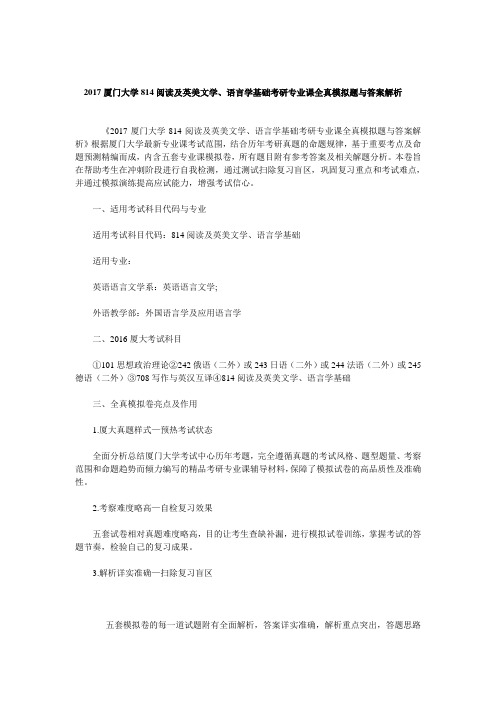
2017厦门大学814阅读及英美文学、语言学基础考研专业课全真模拟题与答案解析《2017厦门大学814阅读及英美文学、语言学基础考研专业课全真模拟题与答案解析》根据厦门大学最新专业课考试范围,结合历年考研真题的命题规律,基于重要考点及命题预测精编而成,内含五套专业课模拟卷,所有题目附有参考答案及相关解题分析。
本卷旨在帮助考生在冲刺阶段进行自我检测,通过测试扫除复习盲区,巩固复习重点和考试难点,并通过模拟演练提高应试能力,增强考试信心。
一、适用考试科目代码与专业适用考试科目代码:814阅读及英美文学、语言学基础适用专业:英语语言文学系:英语语言文学;外语教学部:外国语言学及应用语言学二、2016厦大考试科目①101思想政治理论②242俄语(二外)或243日语(二外)或244法语(二外)或245德语(二外)③708写作与英汉互译④814阅读及英美文学、语言学基础三、全真模拟卷亮点及作用1.厦大真题样式—预热考试状态全面分析总结厦门大学考试中心历年考题,完全遵循真题的考试风格、题型题量、考察范围和命题趋势而倾力编写的精品考研专业课辅导材料,保障了模拟试卷的高品质性及准确性。
2.考察难度略高—自检复习效果五套试卷相对真题难度略高,目的让考生查缺补漏,进行模拟试卷训练,掌握考试的答题节奏,检验自己的复习成果。
3.解析详实准确—扫除复习盲区五套模拟卷的每一道试题附有全面解析,答案详实准确,解析重点突出,答题思路清晰,可以帮助考生更好地进行考前密集训练和冲刺提升。
4. 紧跟命题规律—把握命题趋势通过模拟测试可以审视试卷结构安排,迅速熟悉命题动态,从而帮助考生短时间内掌握考试重点,迅速获得高分秘诀。
5. 模拟考场作战—提升答题技巧考前一个月左右模拟考场进行实战演练,提前适应考场氛围、提升应对考场突发状况的能力,学会合理分配考试作答时间,把握考试节奏,提升答题技巧。
2017厦门大学翻译硕士考研必备参考书
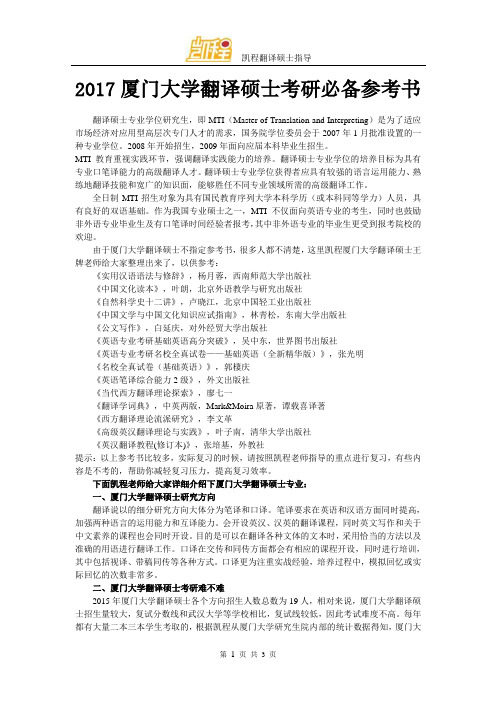
2017厦门大学翻译硕士考研必备参考书翻译硕士专业学位研究生,即MTI(Master of Translation and Interpreting)是为了适应市场经济对应用型高层次专门人才的需求,国务院学位委员会于2007年1月批准设置的一种专业学位。
2008年开始招生,2009年面向应届本科毕业生招生。
MTI教育重视实践环节,强调翻译实践能力的培养。
翻译硕士专业学位的培养目标为具有专业口笔译能力的高级翻译人才。
翻译硕士专业学位获得者应具有较强的语言运用能力、熟练地翻译技能和宽广的知识面,能够胜任不同专业领域所需的高级翻译工作。
全日制MTI招生对象为具有国民教育序列大学本科学历(或本科同等学力)人员,具有良好的双语基础。
作为我国专业硕士之一,MTI不仅面向英语专业的考生,同时也鼓励非外语专业毕业生及有口笔译时间经验者报考,其中非外语专业的毕业生更受到报考院校的欢迎。
由于厦门大学翻译硕士不指定参考书,很多人都不清楚,这里凯程厦门大学翻译硕士王牌老师给大家整理出来了,以供参考:《实用汉语语法与修辞》,杨月蓉,西南师范大学出版社《中国文化读本》,叶朗,北京外语教学与研究出版社《自然科学史十二讲》,卢晓江,北京中国轻工业出版社《中国文学与中国文化知识应试指南》,林青松,东南大学出版社《公文写作》,白延庆,对外经贸大学出版社《英语专业考研基础英语高分突破》,吴中东,世界图书出版社《英语专业考研名校全真试卷——基础英语(全新精华版)》,张光明《名校全真试卷(基础英语)》,郭棲庆《英语笔译综合能力2级》,外文出版社《当代西方翻译理论探索》,廖七一《翻译学词典》,中英两版,Mark&Moira原著,谭载喜译著《西方翻译理论流派研究》,李文革《高级英汉翻译理论与实践》,叶子南,清华大学出版社《英汉翻译教程(修订本)》,张培基,外教社提示:以上参考书比较多,实际复习的时候,请按照凯程老师指导的重点进行复习,有些内容是不考的,帮助你减轻复习压力,提高复习效率。
2008厦门大学814阅读及英美文学、语言学基础考研真题及详解【圣才出品】
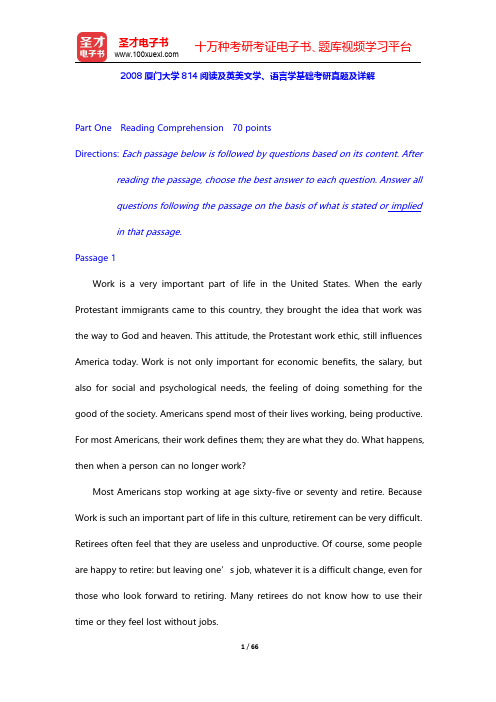
2008厦门大学814阅读及英美文学、语言学基础考研真题及详解Part One Reading Comprehension70pointsDirections:Each passage below is followed by questions based on its content.After reading the passage,choose the best answer to each question.Answer allquestions following the passage on the basis of what is stated or impliedin that passage.Passage1Work is a very important part of life in the United States.When the early Protestant immigrants came to this country,they brought the idea that work was the way to God and heaven.This attitude,the Protestant work ethic,still influences America today.Work is not only important for economic benefits,the salary,but also for social and psychological needs,the feeling of doing something for the good of the society.Americans spend most of their lives working,being productive. For most Americans,their work defines them;they are what they do.What happens, then when a person can no longer work?Most Americans stop working at age sixty-five or seventy and retire.Because Work is such an important part of life in this culture,retirement can be very difficult. Retirees often feel that they are useless and unproductive.Of course,some people are happy to retire:but leaving one’s job,whatever it is a difficult change,even for those who look forward to retiring.Many retirees do not know how to use their time or they feel lost without jobs.Retirement can also bring financial problems.Many people rely on Social Security checks every month.During their working years,employees contribute a certain percentage of their salaries to the government.When people retire,they receive this money as income.These checks do not provide enough,money to live on,however,because prices are increasing very rapidly.Senior citizens,those over sixty-five,have to have savings in the bank or other retirement plans to make ends meet.The rate of inflation is forcing prices higher each year;Social Security checks alone cannot cover Medicare(health care)and welfare(general assistance)but many senior citizens have to change their lifestyles after retirement.They have to spend carefully to be sure that they can afford to but food,fuel,and other necessities.Of course,many senior citizens are happy with retirement.They have time to spend with their families or to enjoy their hobbies.Some continue to work part time:others do volunteer work.Some,like those in the Retired Business Executives Association,even help young people to get started in new business.Many retired citizens also belong to“Golden Age”groups.These organizations plan trips and social events.There are many opportunities for retirees.Americans society is only beginning to be concerned about the special physical and emotional needs of its senior citizens.The government is taking steps to ease the problem of limited income.They are building new housing,offering discounts in stores and museums and on buses,and providing other services,such as free courses,food service,and help with housework.Retired citizens are a rapidlygrowing percentage of the population.This part of the population is very important and we must respond to their needs.After all,every citizen will be a senior citizen some day.1.The early immigrants considered work__________.A.too hardB.importantC.pleasantD.dull2.Why do Americans like working?Because working__________.A.doesn’t only mean money but it is also psychologicalB.can make life more comfortableC.can prove people to be independentD.gives people funny3.We can safely put forward that retirees who__________.A.have no financial problems still want to earn more moneyB.have financial problems still feel lostC.have no financial problems still feel lostD.have no financial problems feels it’s hard to make ends meet4.According to the passage the government__________.A.hadn’t paid attention to the retirees’problemsB.has already solved a lot of retirees’problemsC.has just begun to pay attention to the retirees’problemsD.won’t pay attention to the retirees’problems5.Which of the following is not steps taken for the benefit of senior citizens by the government?A.New housing has been built.B.The old are offered discounts in stores.C.Senior citizens are provided free course,food service.D.None.【答案与解析】1.B根据第一段前两句可知,工作是美国人的生活中非常重要的一部分。
世界文学简史答案

世界文学简史答案【篇一:世界文学简史试题】>院校姓名成绩一、填空题:(每空1分、共10分)1.古希腊的“喜剧之父”是_________“悲剧之父”是_________。
2.〈〈农夫与蛇〉〉、〈〈龟兔赛跑〉〉、〈〈狐狸与葡萄〉〉、这些寓言故事出自_________。
3.奥古斯都时期重要的三位诗人是________、贺拉斯、奥维德。
4.荷马史诗包括〈〈________〉〉、〈〈奥德修记〉〉两部。
5._________的代表作〈〈十日谈〉〉,在结构上采用框形结构。
6._________的〈〈恨世者〉〉被认为是“高级喜剧”的典范。
7.雨果的〈〈_______〉〉是以15世纪路易十一统治下的巴黎为背景的。
8._________被誉为“俄罗斯文学之父”、“俄罗斯诗坛的太阳”。
9.〈〈_________〉〉是中古时期文学中阿拉伯的著名的一部故事集。
二、名词解释(每题5分、共20分)1.“神话”:2.“流浪汉小说”:3.“巴洛克文学”:4.“三一律”:三、选择题(共10分)1.下列属于悲剧诗人埃斯库罗斯对戏剧的贡献的是()a、增加了第三名演员b、悲喜成分相结合c、创造了舞台背景、服装、面具d、善于使用对比手法2.古希腊文学中处于“荷马时代”的主要成就是()a、神话和史诗b、神话和悲剧c、新喜剧和悲剧d、寓言和抒情诗3.“吾爱吾师,但更爱真理”是()的名言a、柏拉图b、亚里士多德c、维吉尔d、但丁4.被称为“中世纪的最后一位诗人,同时又是新时代的最初一位诗人”的是()a、柏拉图b、亚里士多德c、维吉尔d、但丁5.下列属于莎士比亚作品的是()a、〈〈理查三世〉〉、〈〈亨利六世〉〉b、〈〈理查四世〉〉、〈〈亨利一世〉〉c、〈〈堂吉珂德〉〉d、〈〈莎翁情史〉〉6.奥菲丽娅是()中的主人公。
a、〈〈麦克白〉〉b、〈〈仲夏夜之梦〉〉c、〈〈哈姆雷特〉〉d、〈〈第十二夜〉〉7.歌德的()是用一部书建立了伟大的批判的功绩。
2018年厦门大学考研官方指定参考书目★
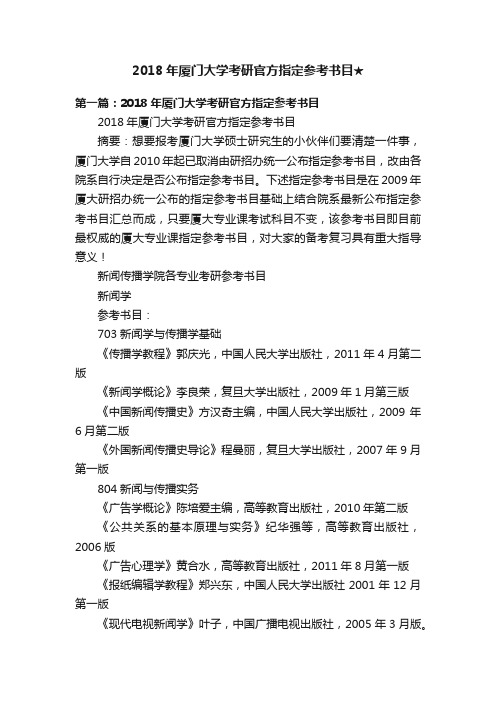
2018年厦门大学考研官方指定参考书目★第一篇:2018年厦门大学考研官方指定参考书目2018年厦门大学考研官方指定参考书目摘要:想要报考厦门大学硕士研究生的小伙伴们要清楚一件事,厦门大学自2010年起已取消由研招办统一公布指定参考书目,改由各院系自行决定是否公布指定参考书目。
下述指定参考书目是在2009年厦大研招办统一公布的指定参考书目基础上结合院系最新公布指定参考书目汇总而成,只要厦大专业课考试科目不变,该参考书目即目前最权威的厦大专业课指定参考书目,对大家的备考复习具有重大指导意义!新闻传播学院各专业考研参考书目新闻学参考书目:703新闻学与传播学基础《传播学教程》郭庆光,中国人民大学出版社,2011年4月第二版《新闻学概论》李良荣,复旦大学出版社,2009年1月第三版《中国新闻传播史》方汉奇主编,中国人民大学出版社,2009年6月第二版《外国新闻传播史导论》程曼丽,复旦大学出版社,2007年9月第一版804新闻与传播实务《广告学概论》陈培爱主编,高等教育出版社,2010年第二版《公共关系的基本原理与实务》纪华强等,高等教育出版社,2006版《广告心理学》黄合水,高等教育出版社,2011年8月第一版《报纸编辑学教程》郑兴东,中国人民大学出版社2001年12月第一版《现代电视新闻学》叶子,中国广播电视出版社,2005年3月版。
备考复习全书:《2017厦门大学新闻传播学院考研专业课复习全书》(含真题与答案)《2017厦门大学新闻传播学院考研专业课全真模拟题与答案解析》传播学参考书目:703新闻学与传播学基础《传播学教程》郭庆光,中国人民大学出版社,2011年4月第二版《新闻学概论》李良荣,复旦大学出版社,2009年1月第三版《中国新闻传播史》方汉奇主编,中国人民大学出版社,2009年6月第二版《外国新闻传播史导论》程曼丽,复旦大学出版社,2007年9月第一版804新闻与传播实务《广告学概论》陈培爱主编,高等教育出版社,2010年第二版《公共关系的基本原理与实务》纪华强等,高等教育出版社,2006版《广告心理学》黄合水,高等教育出版社,2011年8月第一版《报纸编辑学教程》郑兴东,中国人民大学出版社2001年12月第一版《现代电视新闻学》叶子,中国广播电视出版社,2005年3月版。
厦门大学研究生参考书目
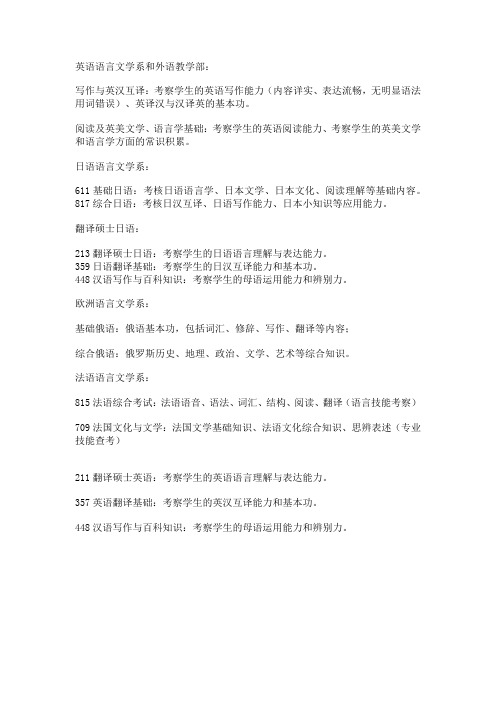
英语语言文学系和外语教学部:
写作与英汉互译:考察学生的英语写作能力(内容详实、表达流畅,无明显语法用词错误)、英译汉与汉译英的基本功。
阅读及英美文学、语言学基础:考察学生的英语阅读能力、考察学生的英美文学和语言学方面的常识积累。
日语语言文学系:
611基础日语:考核日语语言学、日本文学、日本文化、阅读理解等基础内容。
817综合日语:考核日汉互译、日语写作能力、日本小知识等应用能力。
翻译硕士日语:
213翻译硕士日语:考察学生的日语语言理解与表达能力。
359日语翻译基础:考察学生的日汉互译能力和基本功。
448汉语写作与百科知识:考察学生的母语运用能力和辨别力。
欧洲语言文学系:
基础俄语:俄语基本功,包括词汇、修辞、写作、翻译等内容;
综合俄语:俄罗斯历史、地理、政治、文学、艺术等综合知识。
法语语言文学系:
815法语综合考试:法语语音、语法、词汇、结构、阅读、翻译(语言技能考察)
709法国文化与文学:法国文学基础知识、法语文化综合知识、思辨表述(专业技能查考)
211翻译硕士英语:考察学生的英语语言理解与表达能力。
357英语翻译基础:考察学生的英汉互译能力和基本功。
448汉语写作与百科知识:考察学生的母语运用能力和辨别力。
2018厦大考研:814阅读及英美文学、语言学基础专业课备考建议(共5则)

2018厦大考研:814阅读及英美文学、语言学基础专业课备考建议(共5则)第一篇:2018厦大考研:814阅读及英美文学、语言学基础专业课备考建议2018厦大考研:814阅读及英美文学、语言学基础专业课备考建议一个成功的过来人(在读研究生说的这么清新脱俗)的考研经验谈。
来自本人的友人A,厦大某学长的经验分享。
希望能对后辈们有所助益。
先看厦大英语语言文学初试科目:①101思想政治理论②242俄语(二外)或243日语(二外)或244法语(二外)或245德语(二外)③708写作与英汉互译④814阅读及英美文学、语言学基础再看一下往年校方给出的专业课参考书目: 708写作与英汉互译《英汉翻译教程》杨士焯,北京大学出版社,2006 《英译汉教程》连淑能,高等教育出版社,2006 《英汉对比研究》连淑能,高等教育出版社,1993 《英汉比较翻译教程》,魏志成编著,清华大学出版社,2004年《新编汉英翻译教程》陈宏薇主编,上海外语教育出版社,2004年《笔译理论与技巧》何刚强编著,外语教学与研究出版社,2009年《英译中国现代散文选》张培基,上海外语教育出版社814阅读及英美文学、语言学基础《英国文学选读》王守仁,高等教育出版社,2000 《美国文学选读》陶洁,高等教育出版社,2000 《英国文学简史》刘炳善(因为陈嘉那本书据说不好找且内容太厚),河南人民出版社《A History of English Literature》陈嘉,商务印书馆《美国文学简史》常耀信,南开大学出版社或其他高校使用的英美文学史及选读教材《语言学教程》胡壮麟,北京大学出版社《语言学概论》杨信彰,高等教育出版社,2005 一堆的参考书,其实很多都是本科的教材。
其实本科学得好的,这些都是浮云(废话)。
其实咱是建议用这本《2018年厦门大学814阅读及英美文学、语言学基础考研专业课复习全书》,应有尽有,还附带有真题和答案解析。
在7月前把参考书目看过一遍,梳理语言学知识点。
新祥旭权威:厦门大学2017年人文学院中文系考研参考书目

新祥旭权威:厦门大学2017年人文学院中文系考研参考书目中文系初试参考书目:“语言文学基础”考试科目参考书目:1、王力:《古代汉语》,中华书局,2000年。
2、黄伯荣、廖序东:《现代汉语》,高等教育出版社,20003、袁行霈主编:《中国文学史》,高等教育出版社1999年。
4、朱栋霖主编:《中国现当代文学史1917-1997》(上、下册),高等教育出版社1999年。
5、李明滨主编:《世界文学简史》,北京大学出版社,2007年7月第2版。
“文学理论与文学评论写作”考试科目参考书目:1、杨春时等:《文学理论新编》,北京大学出版社,2007年1月版。
2、朱光潜:《西方美学史》,人民文学出版社1979年。
注:“文学评论写作”以古今中外文学经典名作为评论对象。
“语言学”考试科目参考书目:1、王力:《古代汉语》,中华书局,2000年。
(非计算语言学专业书目)2、黄伯荣、廖序东:《现代汉语》,高等教育出版社,2000年。
(共用)3、叶宝奎:《语言学概论》(修订本),厦门大学出版社,2002年。
4、叶宝奎、陈明娥:《语言学概论学习参考》,厦门大学出版社,2005年。
(共用)5、叶蜚声徐通锵:《语言学纲要》,北京大学出版社,2006年。
(共用)6、黄昌宁、李娟子《语料库语言学》,商务印书馆(计算语言学参考书)复试参考书目:文艺学专业:1、杨春时著:《文学理论新编》,北京大学出版社,2007年1月版。
2、《西方美学史》,朱光潜著,人民文学出版社1979年版。
3、《美学》,杨春时著,高等教育出版社2004年版(选讲部分不考)。
语言学及应用语言学专业:1.苏新春《汉语词义学》,广东教育出版社,1997年(非计算语言学方向复试用书)2.齐沪扬陈昌来《应用语言学纲要》,复旦大学出版社,2004年(共用)3. Visual Basic程序设计唐大仕清华大学出版社2004年(计算语言学方向复试用书,其他同上) 汉语言文字学专业:汉语言文字学专业:1.何九盈《中国古代语言学史》,北京大学出版社,2007年。
2017年厦门大学专业课考研真题861语言学(回忆版)

2017年厦门大学专业课考研真题861语言学(回忆版)2017年厦大考研初试已经结束了,聚英厦大考研网为大家搜寻整理了2017年厦门大学专业课考研真题861语言学,由于都是网友们的回忆版,或与原试卷有所出入,欢迎广大考生们纠正补充,希望小编整理的厦大专业课历年真题对你有所帮助。
一、名词解释:
声训双声叠韵平仄韵例
二、简答:
1.扬雄的《方言》
2.古今义的异同的原因
3.句子和短语的区别
三、论述:
1.结合贾母把羹汤喝完了的6个变句式,分析汉语语法的特点
2.从陈第的一句话文字和语音的演变
四、语言运用:
分析词语重叠的构造方式(潺潺爸爸猩猩…)
结合句子分析“白”字的义项
古文翻译:
断句加标点及翻译加点词义,文段与司马子有关
以上就是聚英厦大考研网的资料汇总,想必同学们还想了解更多的关于考研资料、真题、报录比、招生简章、考试大纲等考研资讯和信息,大家可以登录聚英厦大考研官网免费查看和下载。
厦门大学硕士研究生学费奖助学金一览表
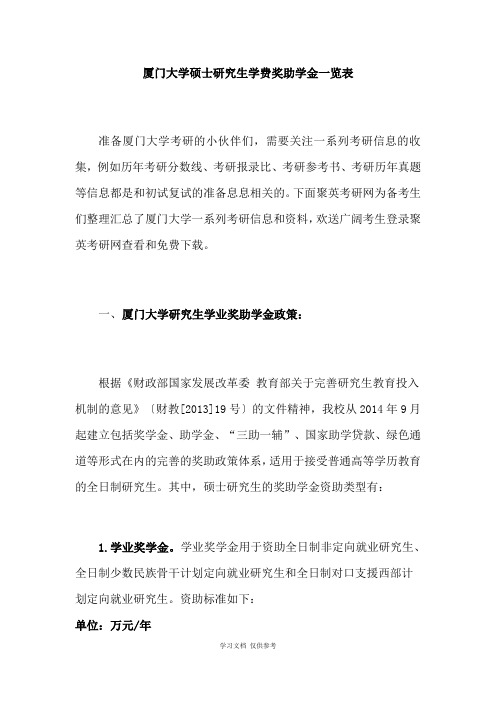
厦门大学硕士研究生学费奖助学金一览表准备厦门大学考研的小伙伴们,需要关注一系列考研信息的收集,例如历年考研分数线、考研报录比、考研参考书、考研历年真题等信息都是和初试复试的准备息息相关的。
下面聚英考研网为备考生们整理汇总了厦门大学一系列考研信息和资料,欢送广阔考生登录聚英考研网查看和免费下载。
一、厦门大学研究生学业奖助学金政策:根据《财政部国家发展改革委教育部关于完善研究生教育投入机制的意见》〔财教[2013]19号〕的文件精神,我校从2014年9月起建立包括奖学金、助学金、“三助一辅”、国家助学贷款、绿色通道等形式在内的完善的奖助政策体系,适用于接受普通高等学历教育的全日制研究生。
其中,硕士研究生的奖助学金资助类型有:1.学业奖学金。
学业奖学金用于资助全日制非定向就业研究生、全日制少数民族骨干计划定向就业研究生和全日制对口支援西部计划定向就业研究生。
资助标准如下:单位:万元/年2.助学金。
研究生助学金由国家助学金和校长助学金组成,用于补助研究生基本生活支出,适用于全日制非定向就业研究生、少数民族骨干计划定向就业研究生和对口支援西部计划定向就业研究生。
其中,少数民族骨干计划非全日制定向研究生和对口支援西部计划非全日制定向研究生只享受国家助学金。
资助标准如下:单位:万元/年3.国家奖学金和校级奖学金。
国家奖学金每学年评选一次,硕士研究生2万元/人;校级奖学金每学年评选两次,各奖项奖励金额2000元/人—10000元/人不等。
具体名额和评审方法以当年评奖通知为准。
4.学校每年投入9000余万元用于研究生担任助研、助教、助管和学生辅导员岗位,研究生可通过申请相关岗位获得资助。
注:1.以上奖助学金方案假设有调整,请以我校相关最新政策为准。
方法执行,各类奖助学金需在学生缴清相关费用后才发放,全日制非定向研究生、全日制少数民族骨干计划定向研究生和全日制对口支援西部计划定向研究生需将档案和人事关系转入我校并通过资格审查后方可发放学业奖学金、国家助学金和校长助学金。
- 1、下载文档前请自行甄别文档内容的完整性,平台不提供额外的编辑、内容补充、找答案等附加服务。
- 2、"仅部分预览"的文档,不可在线预览部分如存在完整性等问题,可反馈申请退款(可完整预览的文档不适用该条件!)。
- 3、如文档侵犯您的权益,请联系客服反馈,我们会尽快为您处理(人工客服工作时间:9:00-18:30)。
《2017厦门大学814阅读及英美文学、语言学基础考研专业课复习全书》
《2017厦门大学814阅读及英美文学、语言学基础考研专业课复习全书》主要包含核心考点解析和2003-2014年真题及详细答案解析。
本书系统全面总结考研专业课知识,重难点分明,深度解析历年考研真题并进行命题预测,为考生节省大量宝贵的复习时间,帮助考生在扎实基础之上迅速提高专业课成绩,是2016年考生从基础到冲刺阶段必备的考研专业课资料。
年年相伴考研,年年更新完善,衷心希望本书能切实地帮助到每位考生,继续得到各位考生的喜爱!
一、适用考试科目代码与专业
适用考试科目代码:814阅读及英美文学、语言学基础
适用专业:
英语语言文学系:英语语言文学;
外语教学部:外国语言学及应用语言学
二、2016厦大公布的考试科目
①101思想政治理论②242俄语(二外)或243日语(二外)或244法语(二外)或245德语(二外)③708写作与英汉互译④814阅读及英美文学、语言学基础
三、本书部分简介
1.参考书核心考点解析——面面俱到的专业课内容精粹是本书的核心内容,按考试科目的内容分为语言学、文学、翻译、写作及阅读共三篇,每篇包括的内容如下所示:
A:语言学
每个章节包括以下几块内容:
(1)知识框架
(2)复习提示
(3)知识详解考题预测
(4)考点分析(考点提炼、评估重要程度)
(5)考题预测
B:文学
(1)学科整体介绍及复习建议
(2)背景知识
(3)作家作品集锦
(4)名词解释集锦
(5)作品人物分析(英美两国作家各时期作品人物分析)(6)问答题集锦
(7)诗歌鉴赏(诗歌实例分析讲解)
(8)习题及参考答案
C:阅读
(1)近年优秀考生和名师经验总结
(2)阅读题型全攻略
2.专业课历年真题及答案解析——分析入理的经典真题大观
(1)历年真题原题(2003—2014年,真题原貌);
(2)参考答案及解题分析(2003—2014年);
(3)答题高分技巧(题型解析、真题举例)。
